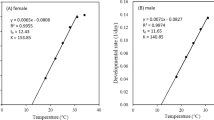Abstract
Developing eggs of the host snail Lymnaea acuminata were experimentally parasitized with the parasitic rotifer Proales gigantea to study the population growth rate of the parasite within the snail egg capsule and the susceptibility of the host eggs at different stages of embryonic development. The population growth rate of P. gigantea was 0.46 ± 0.07 individual−1 day−1 at the ambient temperature of 18–22 °C. Snail eggs were most susceptible to rotifer attack during the initial stages of development, becoming progressively more resistant after the ‘hippo’ stage. Yet, regardless of the stage of development, the host embryo was doomed to die without hatching even if one individual rotifer gained entry inside the egg capsule. The presence of P. gigantea within the parasitized egg capsules or in the mucilage had no effect on the developmental rates and hatching success of non-parasitized eggs within the same egg mass.
Similar content being viewed by others
References
Hassan, A. A., A. M. S. El-Ridi & I. A. A. Magd, 1985. An approach to biological control of snails by rotifers. J. Egypt. Soc. Parasitol. 15: 553–558.
Koste, W., 1972. Uber zwei seltene parasitische Rotatorienarten Drilophaga bucephalus Vejdovsky und Proales gigantea (Glascott). Osnabrucker Naturw. Mitt. 1: 149–158.
Malek, E. A. & T. C. Cheng, 1974. Medical and economic malacology. Academic Press, New York 398 pp.
Maly, E. J., 1975. Interactions among the predatory rotifer Asplanchna and two prey, Paramecium and Euglena. Ecology 56: 346–358.
May, L., 1989. Epizoic and parasitic rotifers. In C. Ricci, T. W. Snell & C. E. King (eds), Rotifer Symposium V. Developments in Hydrobiology 52. Kluwer Academic Publishers, Dordrecht: 59–67. Reprinted from Hydrobiologia 186/187.
Ricci, C. N., 1987. Ecology of bdelloids: how to be successful. In L. May, R. Wallace & A. Herzig (eds), Rotifer Symposium IV. Developments in Hydrobiology 42. Dr W. Junk Publishers, Dordrecht: 117–127. Reprinted from Hydrobiologia 147.
Stemberger, R. S., 1990. Food limitation, spination and reproduction in Brachionus calyciflorus. Limnol. Oceanogr. 35: 33–44.
Author information
Authors and Affiliations
Rights and permissions
About this article
Cite this article
Ramakrishna Rao, T. Population growth rate of the parasitic rotifer Proales gigantea, and susceptibility to parasitization in the snail Lymnaea acuminata at different stages of embryonic development. Hydrobiologia 254, 1–6 (1993). https://doi.org/10.1007/BF00007760
Received:
Revised:
Accepted:
Issue Date:
DOI: https://doi.org/10.1007/BF00007760



